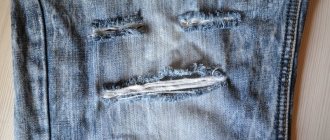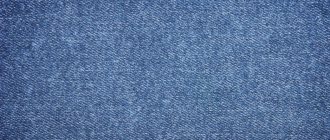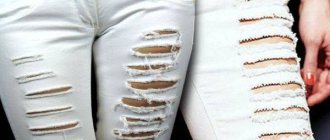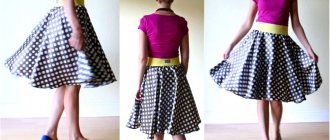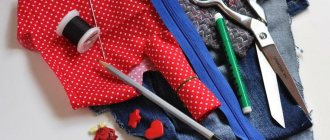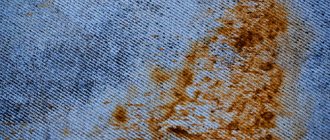Patch sewing technology
Decorative and functional patches are applied to the front side of the main part of the product. In this case, the edge is fixed on the machine using a straight stitch or zigzag. To restore the fabric, the patch part is hidden and sewn with hidden stitches. When choosing a method to reinforce a frayed area, choose machine stitching - it provides a stronger hold than hand stitches.
Method 1
If jeans or trousers are frayed along the crotch seam, they can be restored as follows.
- Choose thick fabric or similar denim. Cut a piece into a shape slightly larger than the damaged area. It is enough to increase the area along the contour by 1.5-2.0 cm.
- Turn the pants inside out and straighten the fabric, ironing it to make it more even and smooth.
- Apply a patch to the jeans, secure with hand running stitches, pins or glue web.
- Turn the jeans inside out.
- Place the work area under the sewing machine foot with the front side facing up.
- Choose a straight or zigzag stitch. The stitching direction may not coincide with the grain direction of the fabric.
- Sew tightly the area of damaged tissue, extending 1.0 cm beyond its contours, fixing the reinforcing material.
- Iron the finished patch on both sides, flattening the area and relieving the tension of the stitching.
Method 2
If you do not have a sewing machine, it is recommended to secure the patch manually using another method. When using manual attachment technology, the part will be visible from the front side. Therefore, it is recommended to choose a fabric to match the main one or find a similar density. The advantage of this method is that it can block the break, and not just hide the fibers destroyed as a result of wear.
- Select the fabric to match the main one, cut out a patch 1.0-2.0 cm larger than the contour of the hole. The directions of the lobar two tissues must coincide.
- Place a piece of fabric with the wrong side on the wrong side of the product, first secure with pins.
- Align the patch, working from the front side.
- Fold the edges of the tear inward by 0.5-0.7 cm, securing them with pins. At this stage, the edges can be fixed with an iron.
- Hem the edges with blind stitches by hand using matching thread.
- Iron the resulting finished surface of the part.
Method 3
Decorative and functional patches are sewn on in a different way. They are not hidden, but are customized along the front surface.
- Select a chevron or patch in accordance with the style of the product. This can be an adhesive-based applique. Ready-made oval pads are suitable for elbows. Another option is to cut them yourself from dense material.
- Place a clothing model on a figure or mannequin. Pin the patch on the front side in accordance with the idea and proportions.
- Remove the product and place it on the table.
- Pin or baste a patch.
- Sew the decorative trim onto the edge of the piece using a straight or zigzag stitch.
- Carefully iron the resulting patch on both sides.
Based on these three methods of how to sew a patch, you can create your own optimal option for a specific request. For example, it makes sense to patch a torn knitted sweater using a knitted patch with an elastic stitch or by hand. A torn leather product is first glued from the wrong side, then the tear is closed from the face.
The fashion for rock, grunge and alternative as a contrast to gloss and luxury suggests stylish negligence and is perfectly emphasized by torn, seemingly worn edges and elements. Decorative, ostentatious patches are a great way to enhance a fashionable look and make a statement. Some designers build collection lines based on the principle of applying patches.
Types of patches
Varieties of patches are presented in a large number of options. Before you put a patch on, you need to work out what it could be. Based on their properties, they are divided into several groups.
What is it used for?
Such decorative products can have absolutely any shape. They are sewn on the front of the product.
Patches allow you not only to deal with fabric damage, but also to simply decorate your favorite piece of clothing. You can use set-in patches to restore the area between your legs. But to achieve aesthetics, you need to sew patches in several more places on the trousers.
The patch is represented by two parts that are identical in shape, but slightly different in size. First, the smaller element is sewn on the back side, and then the larger one on the front side. In this case, hand-blind stitches are used so that the patches serve a decorative function.
These patches are designed to repair worn knees and elbows on garments.
This is an extremely simple type of patch, which is also considered not very reliable. If sewn correctly, the product will be invisible, but its service life is very limited.
Patches can be used to repair fabric damage anywhere on any garment.
Such a patch must be sewn from the inside of the material along the contour. Also, in some cases, it is possible to sew the product on the outside using a zigzag stitch.
Internal linings are used in cases where the fabric begins to tear from the inside.
They are needed to strengthen certain parts of clothing so that they look beautiful. A patch can be created specifically on a new product to accentuate attention.
Typically, patches are placed on the elbows and knees of garments to further strengthen them.
They are presented in bright colors of fabrics. They are found on any item of clothing, not always taking into account functionality.
Decorative patches can be sewn anywhere on a garment to attract attention.
They can be presented in the form of animals, flowers, logos and other unusual shapes. Such products can play both a functional and decorative role.
Patches are in demand on any area of clothing where there is a need for it.
Important! It is necessary to sew on a material that differs from the fabric of the product in a wet state. This will prevent the product from deforming during the washing process.
| Type of patches | Peculiarities | What is it used for? |
| Set-in | Such decorative products can have absolutely any shape. They are sewn on the front of the product. | Patches allow you not only to deal with fabric damage, but also to simply decorate your favorite piece of clothing. You can use set-in patches to restore the area between your legs. But to achieve aesthetics, you need to sew patches in several more places on the trousers. |
| Double sided | The patch is represented by two parts that are identical in shape, but slightly different in size. First, the smaller element is sewn on the back side, and then the larger one on the front side. In this case, hand-blind stitches are used so that the patches serve a decorative function. | These patches are designed to repair worn knees and elbows on garments. |
| Invoices | This is an extremely simple type of patch, which is also considered not very reliable. If sewn correctly, the product will be invisible, but its service life is very limited. | Patches can be used to repair fabric damage anywhere on any garment. |
| Domestic | Such a patch must be sewn from the inside of the material along the contour. Also, in some cases, it is possible to sew the product on the outside using a zigzag stitch. | Internal linings are used in cases where the fabric begins to tear from the inside. |
| Functional | They are needed to strengthen certain parts of clothing so that they look beautiful. A patch can be created specifically on a new product to accentuate attention. | Typically, patches are placed on the elbows and knees of garments to further strengthen them. |
| Decorative | They are presented in bright colors of fabrics. They are found on any item of clothing, not always taking into account functionality. | Decorative patches can be sewn anywhere on a garment to attract attention. |
| Artistic | They can be presented in the form of animals, flowers, logos and other unusual shapes. Such products can play both a functional and decorative role. | Patches are in demand on any area of clothing where there is a need for it. |
Types of patches
Today there are many options for patches. Before you start repairing clothes, you need to decide which one will be used.
Depending on their properties, patches are divided into several groups:
Set-in patch
- Set-in items are decorative items that can be of any shape. They are sewn onto the front part and help combat damage to fabrics, and are also used as decorative elements. With these patches you can restore the area between your legs.
- Double-sided - these patches are represented by two parts identical in shape, which only differ in size. In order for the patches to serve a decorative function, they are sewn on by hand with blind stitches. Used to restore items with worn knees and elbows.
- Invoices are the simplest type of patches. However, they are not reliable. Used to repair damage to any item of clothing.
- Internal - sewn along the contour of the material from the inside. Used in cases where the fabric begins to tear from the inside.
- Functional - used to strengthen parts of clothing in such a way that it looks aesthetically pleasing. These patches can even be used to highlight new clothing. These types are used on elbows and knees to strengthen the material.
- Decorative - such patches are made from bright fabrics and are found on any item of clothing to attract attention.
- Artistic - represent logos, flowers or animals that play not only a functional, but also a decorative role. Sewn onto various areas of clothing.
Decorative patches on a dress
In addition, before sewing a patch by hand, you need to decide on the material used.
Native fabric
The simplest method is patches made of fabric that matches the texture and color. To avoid purchasing fabric, you can use a fragment. It can be cut from places that are hidden, such as under pockets. And in place of the cut out fragment, other fabrics are sewn.
Patch made from native fabric
Adhesive fabric
When working with abrasions, this is the fabric that is mainly used. Before sewing on a patch of adhesive fabric, steam the damaged area and then use an iron to glue the web. Once all the steps are completed, it is recommended to machine stitch it with a zigzag seam. The threads should be matched to the tone of the product.
Adhesive patch
Lace
An original method for eliminating holes in a product and decorating it. Such patches look especially impressive on denim. They are sewn on just like everyone else. To create them, you can use guipure of any color, but the most impressive thing, for example, is white lace on black jeans, and, conversely, it is best to sew black lace on light jeans.
Thermal patches
This method is considered the most elementary. Thermal patches are textile pictures on an adhesive basis. They can be made in the form of flowers, logos or mice, as well as other animals. Gluing them is very easy, especially on trousers or trousers. To do this, you need to apply a patch on the outside to hide the torn area and go over it with a hot iron.
Thermal patches for the product
DIY patches for jeans
join the discussion
Share with your friends
Modern people tend to throw away things that have lost their presentation. Even if a garment has just one stain or small snag, it often ends up in the trash.
But is it really necessary to get rid of good clothes that can last several more seasons if the defect can be fixed on your own? After all, many of us have already forgotten that torn clothes can be darned and patched: this will save your family and budget and not clutter your wardrobe with an abundance of things.
We invite you to familiarize yourself with Daily garbage - news from the Vladimir region
In today's article we will tell you how you can restore torn jeans to proper shape using patches. You will learn several simple and effective ways to repair trousers that even a novice needlewoman can handle.
Removing holes
The technology for making patches will vary slightly, depending on where the jeans are torn. Typically, pants tear in areas that are subject to friction or stretching.
Most often these are the knees and the area between the legs. If in the first case the patch is noticeable, even if it is made very carefully, then you can sew the patch between your legs so that no one will even guess about its presence.
In addition to the sewing machine you will need:
Between the legs
Before you begin the main work, you need to give the hole a neater appearance.
To do this, cut off the long threads sticking out from its edges. Then the edges of the hole need to be swept together so that it does not continue to increase in size. We do this manually. The stitches should be fairly frequent, but wide.
Sew not tightly: there should be no creases in the fabric or a hard, protruding seam at the hole site. The torn area should be made as smooth and even as possible.
Next, you need to cut out a patch of a suitable shape and size. It should be slightly larger than the hole itself. We will sew the patch on the wrong side of the jeans so that it is less noticeable.
It is recommended to first secure the patch in place with pins - this way you will not have to constantly ensure that it does not move during the process.
Now turn on the sewing machine, thread the thread and start sewing (this is the name of the process of sewing on a patch). Select the zigzag mode and lay stitches over the entire surface of the patch.
You should try to make lines as close to each other as possible. It is most convenient to use the reverse function for this; If your unit does not have one, you will have to start the line from the beginning each time.
Upon completion of the work, fasten and cut the thread.
On my knee
In the knee area, jeans most often tear in children who do not sit still for a minute. Buying new trousers every time such a nuisance occurs would be a real waste, because a damaged item can be easily and quickly repaired with your own hands.
A patch on the knee, even if it is made with great skill, will almost certainly be noticeable upon closer inspection. That's why we offer you a way to repair jeans, in which the patch becomes a stylish design element.
To do this, you will need a piece of denim in a contrasting shade. For example, bright blue denim patches will look impressive on black jeans. You can cut a suitable piece from an old denim item that you definitely won’t wear again.
- So, the first thing you need to do is decide on the size of the patch and cut out a suitable fragment.
- The patch should be as wide as a trouser leg and long enough - about 15 cm. If it is difficult for you to cut a piece out of fabric evenly the first time, first make a pattern from paper. Don't forget to allow a small hem allowance - about 0.5 cm.
- Fold the patch over the edges and baste.
- Now you can sew it to the trouser leg. It is most convenient to do this on a sewing machine, but you can also do it by hand.
- This method involves the presence of such inserts on two legs - this way the result looks more finished and aesthetic. So do the same on the other leg.
If you have a large piece of leather, it can also be used as knee patches.
It will not be possible to sew jeans at the knee without it being noticeable. However, for lovers of handmade work, in this case there are many opportunities to show creative imagination.
Below are some of the most obvious options for decorating a hole in the knee:
- Denim patch in contrasting color.
- A patch made of printed fabric of a different type and texture.
- Contrasting decorative darning.
- Application.
- Leather patch.
Decorative patches can be sewn on the front side or peeking out from the gap on the back. They can be done on both knees, placed symmetrically, or on just one.
Repairing frayed jeans
In order to avoid having to sew up holes in your favorite trousers, you should treat the item with care and care for it appropriately from the first day of purchase. But let's consider a situation where the jeans are already worn out.
For example, on jeans between the legs not only abrasions have appeared, but the seam itself is starting to unravel. To prevent fabric tearing, follow these steps:
- We place emphasis on strengthening the seam, otherwise the trousers may crack at the most inopportune moment. You can reinforce the seam not only using a machine, but also manually using the blind stitch technique. To do this, specialized sewing stores sell super-strong threads for working with denim materials. They have a color that matches the classic stitching on jeans.
- Then you should mend the worn areas of the trousers. For this purpose, choose threads that match the thickness of the denim as well as its shade. After laying out the denim, secure the stitches to the still strong areas of the fabric and make horizontal movements with the stitches over the worn part of the trousers. Insert the needle into the torn edge and use a vertical stitch to go back. These manipulations are necessary to ensure that the fabric does not tighten or warp.
- After completing the horizontal row, start the vertical row so that the needle passes between the threads. In fact, it turns out that you are weaving new fabric to replace the leaky one.
How to make a patch between your legs
This method is used for a relatively small area of abrasion, that is, when there is no obvious hole yet, but abrasion is already noticeable. To prevent the situation from getting worse over time, you should immediately strengthen the denim fabric. For these purposes, you will need patches made of denim material, specialized fabric glue or self-adhesive tape , popularly called “spider web”.
Apply thermal tape to the worn jeans fabric, covering it with a denim patch on top. The durability of this repair depends on the quality of the “web”. Also, do not forget that the more often you wash your jeans, the less the patch will last. However, if you stitch around its perimeter, it will last much longer.
If time permits, try looking in specialized sewing stores for ready-made denim patches, the other side of which is made of self-adhesive tape. This type of repair is performed using an iron. However, if the hole is large enough, the wearing process after this type of repair will become completely uncomfortable. Since the fabric becomes significantly denser, and therefore wrinkles worse, this area will be quite rough, which will cause discomfort during wear.
Do it yourself or manually
to mend jeans :
- mend jeans between the legs using a machine;
- seek help from a workshop so that a specialist can properly patch the hole;
- sew it up yourself on the knee, holding it with your elbows, which is the cheapest method, but at the same time quite painstaking.
Blind stitch patch by hand
If the hole has formed on the knee, and it is large enough, during the repair process you should follow the step-by-step instructions below:
- Trim the threads sticking out around the perimeter without going into the fabric.
- Turn the jeans inside out and circle the hole, making an indentation from the edge of about 2-3 cm. If possible, it is better to process the edges of the hole not with your hands, but with an overlocker. But in this case the patch will be more noticeable.
- Prepare the self-adhesive tape by cutting it to the desired size. Do the same with a piece of fabric for sealing your pants. Ideally, you should cut it diagonally in the direction of the weave of the thread. Thanks to this, the fabric will not unravel or fray.
- Glue the web and denim patch using a heated iron. Steam the patch a little, especially around the edges.
- Sew around the perimeter of the pants patch using blind stitches.
- Turn the jeans right side out and make the correct horizontal stitches. The most suitable stitch for this would be a zigzag stitch.
- Cut off the excess threads and the repair is complete.
What material is suitable
It is not always possible to find denim identical in color and texture to jeans. And you shouldn’t do this, because a patch made from a different material will look much more interesting. Current options:
- Ripped jeans have been in fashion for several seasons now. This season, the combination of ripped jeans with all kinds of patches is popular. The model looks feminine and gentle with lace sewn under the torn edges. Classic blue jeans with patches are combined with white, cream lace, and black, gray, dark blue models will look with black or deep blue lace;
- jeans can be decorated with thick pieces of fabric. Here the flight of fancy is not limited: a country flag, a picture, a drawing from a comic book. However, you shouldn’t get too carried away with bright patches, otherwise your jeans will look too pretentious. The style and color of the patches on jeans should match the top of the clothing;
- young people love patches made from various colored scraps. The main thing is to follow the principles of color combinations.
It’s not always possible to find a suitable piece of denim at home, and spending time buying a few centimeters of denim in a sewing store is completely impractical.
However, experienced needlewomen have come up with several possible options for getting out of the situation. Let's look at the most interesting of them.
The easiest way to find a fabric that matches the color and texture is to cut a piece from the very jeans that need repair. But you need to choose a place where the absence of a fragment of material will not be noticeable.
The only such area of jeans is the place under the back pockets. From here you can borrow a little material without compromising the overall appearance of the product.
Instead of the cut out fragment, you can sew any other fabric, because the inside of the pockets is invisible to others. The main thing is to choose a fairly dense material and firmly sew the jeans on the wrong side.
We use glue
Adhesive fabric, which is also called “cobweb”, can be used only when we are not dealing with through holes, but with severe abrasions that are at risk of turning into holes.
- The area of jeans that needs to be strengthened with adhesive material must first be thoroughly steamed and ironed.
- Then a small piece of cobweb is glued using the same iron.
- It is recommended to secure the result by stitching the worn area on a sewing machine with a zigzag seam.
- Threads should be chosen to match the main material of the product.
The materials of the flaps that are used as patches may be different. They depend on the type of patch, its purpose and some other factors. The most commonly chosen materials are:
- natural or artificial leather, which is highly resistant to wear;
- the main material of the garment where the patch is needed, or as similar as possible to it;
- any textured types of fabrics, for example, suede or velvet;
- decorative thermal applications;
- ready-made patches that are decorated with drawings or ornaments.
It’s not always possible to find a suitable piece of denim at home, and spending time buying a few centimeters of denim in a sewing store is completely impractical.
However, experienced needlewomen have come up with several possible options for getting out of the situation. Let's look at the most interesting of them.
The easiest way to find a fabric that matches the color and texture is to cut a piece from the very jeans that need repair. But you need to choose a place where the absence of a fragment of material will not be noticeable.
The only such area of jeans is the place under the back pockets. From here you can borrow a little material without compromising the overall appearance of the product.
We use glue
What can a patch be made from?
The material for the patch can be chosen to match the pants, or contrasting accents can be made. It can be leather or its substitute, suede, tweed - with all types of jeans such patches will look organic and impressive.
Important! Today, in specialized stores you can purchase ready-made and even edge-processed patches of various shapes, sizes, colors and from various materials.
If you want your patch to not stand out, it needs to be made from “native” material. The easiest way is to cut a piece from the very jeans that need repair. The only place where you can cut a piece for a patch without loss is the place under the back pockets.
Important! Instead of the cut-out fragment, you can sew any other fabric, because the inside of the pocket is still not visible to others. The main thing here is to choose a dense material that will not fall apart.
How to sew a patch using a sewing machine?
It is not difficult to sew on the patch correctly. The first thing that is necessary is to prepare the necessary tools and materials. Among them are the following:
- scissors;
- threads to match the selected piece of fabric;
- a scrap that will become a patch, or a finished product;
- set of safety pins.
We suggest you familiarize yourself with How to lengthen a dress: tips from stylists on how to lengthen a dress
It is also worth making sure that the item of clothing on which the patch will be sewn is clean and dry. To do this, the item needs to be washed, dried and ironed. The patch itself must also be clean. This will allow you to achieve comfort while working.
There are several ways to sew a patch by hand. It is worth choosing the most suitable one in a particular case. Among the main ones it is worth highlighting the following:
- Blind seam. It will not be visible from the outside, so the patch will look “in its place.” To do this, the edges of the tear are folded inward by 0.5-0.7 cm, secured with pins or ironed and hemmed.
- Seam using bright threads, beads, sequins. It will become a bright accent on a piece of clothing.
- Rough hand stitch. Additionally, you can fray the edges of the patch. This will ensure that the item of clothing matches the grunge style.
- Regular seam for backing patches. In this case, the hole remains, but it is covered from the inside with bright fabric, possibly with additional decorative elements.
You can sew on a patch using a sewing machine. The operating algorithm in this case is as follows:
- You need to cut a patch from a suitable material or purchase a finished product.
- The item where the patch is to be sewn should be turned inside out. If the fabric allows, it is recommended to iron the damaged area for the convenience of further work.
- Now you should place the patch on the torn area and secure it using running stitches (this is done by hand). If you don't want to make stitches, you can simply attach the patch to the fabric using glue web or pins.
- Turn your sweater or jeans inside out.
- Choose a zigzag or straight stitch on your machine. Don’t worry if it doesn’t coincide with the grain direction of the fabric when sewing.
- Sew the damaged area so that the machine stitch is located approximately 0.8-1 cm beyond it. Don't forget to fix the patch while sewing.
- Iron the patch on both sides.
- Remove pins or basting stitch.
Using this method, you can sew a patch on any product: a jacket, a shirt, a sweater, jeans, sweatpants, and even an ordinary sheet. It is important to consider the material of clothing or linen and patches. Thus, it is possible to restore, for example, torn jeans.
Attention! Keep in mind that any patch should be 2-2.5 cm larger than the hole.
A neat patch on the elbows will allow you to restore the damaged area of the fabric. To give a textile item an original look, you can use the so-called woolen heel. This will look especially interesting on a light sweater, which is sewn from dense material, or on a sweatshirt. The algorithm of actions is not very complicated:
- Prepare everything you need. You need to take a damaged item of clothing, a sponge made of thick fabric, any shape (for example, a pastry shop), felting needles, tape and wool of the selected shade.
- Now you need to mark the places where the stripes will be applied. To do this, you need to put on a sweater and stick pieces of tape on your elbows at a distance of 2-3 cm from the fold. This will ensure the patches are positioned perfectly.
- You need to take off your sweater and put a sponge in the torn sleeve. You need to place the form on it so that its lower edge is located on the tape.
- You need to lay out colored wool on top of the form.
- Now you need to felt the wool in the usual way, piercing it with a needle, which is located at a right angle. You need to work until you get a dense layer of wool without any fluffiness.
- Remove the mold and secure the patch by steaming with an iron.
You can decorate the second sleeve in the same way. A product with two decorative elements will look much more harmonious and interesting. If the work was done correctly and in accordance with the algorithm, the patches do not require any special care. They will delight you for a long time.
Small holes in jeans can be sewn up by hand. How to sew jeans between the legs with thread? Everything is very simple. You will need threads to match the denim, scissors and a thick needle. To repair, we use a “blind” stitch - this way the hole will quickly disappear and the seams will become invisible.
Technique:
- Carefully trim any loose threads around the hole. And be careful not to cut the fabric, otherwise the hole will become wider.
- Start stitching the hole vertically from the inside. Step back 2 centimeters from the right edge and start stitching.
- Continue making stitches and layering them until they are as tall as the hole. Finally, pull the thread and the stitches will become invisible.
- Secure the thread with a knot and cut it.
Now you know how to quietly and beautifully sew up torn jeans with a regular needle and thread.
How to quietly sew up a hole in jeans if it appears in a visible place, namely on the butt? Let's save your favorite trendy jeans!
- sewing machine;
- threads of two colors - gray and white;
- iron;
- scissors;
- a piece of dublerin.
Technique:
- Completely iron the jeans if they are wrinkled. We also iron the hole area.
- We put a piece of dublerin on the hole and iron it from the inside and outside.
- Using a sewing machine, we process the edges with light threads from the wrong side perpendicular to the hole. Stitch length - no more than 2.5 mm.
- With dark threads we sew even stitches perpendicular to the light ones and on top of them. This is how we repeat the structure of denim.
If you have a small hole in your knee and don’t know how to beautifully sew up a hole in your jeans, then we have a solution! We offer a simple way to manually sew jeans at the knee without a patch. Threads to match the color of your jeans, scissors, a needle and an iron - that’s all you need.
Technique:
- How to sew jeans without using a machine? Start by cutting off the frayed edges around the hole. Try to cut as close to the hole as possible, without accidentally cutting off “healthy” material.
- Turn the jeans inside out and use thread and a needle to stitch the hole several times. Make the stitches as close together as possible.
- Fasten and trim the thread and get rid of any protruding material.
- And now the main life hack is how to sew jeans on your leg so that it is not visible. Heat the iron and “seal” the area you just repaired. The iron will even out the surface and the seam will be less noticeable.
How to sew a patch on jeans manually: the original method
There are several options for patches:
- double-sided patch - will help hide holes in the knees, scuffs on the elbows in denim jackets, dresses, shirts. The patch consists of two pieces of fabric, identical in shape, but different in size. First, a smaller piece is sewn from the reverse side in the place that needs restoration. After this, a larger part is sewn on the front side. Often a blind hand stitch is used for double patches because the machine stitching will be obvious;
- set-in patches are used to decorate any places on jeans, even between the legs;
- overhead pieces of material serve rather as a decorative element due to unreliability. The overlay piece of fabric is sewn on the front side with a hidden seam. Decorative patches for jeans are often made from fabric that differs in color.
Manually
Let's look at how to make a patch, using jeans as an example, where you need to hide a hole in the knee. How to make knee patches on jeans by hand:
- It is better to choose a knee patch from a denser material. Handicraft stores sell ready-made patches of various shapes, colors and textures. If you want to make it yourself, you first need to prepare a template from thick paper, then transfer it to a piece of fabric and carefully cut the patch to shape;
- the edges of the patch can be overcast or a small fringe can be made;
- the color of the threads can be absolutely any: contrasting with jeans or in the same range;
- first, baste the patch, iron the fabric using a hot iron;
- then carefully sew the patch to the knee using small stitches;
- You can sew the same patch to another leg, after which the jeans are washed and laid out to dry.
Typewriter
If you have a sewing machine, sewing a patch on jeans is not difficult. Functional patches, just like decorative patches, are attached to the front side of the product. The edge is fixed with a straight stitch or with a zigzag. If you want to hide a worn place on the fabric under a patch, give preference to machine stitching, since this way you can fix the patch more reliably. Decorative patches can be stitched with threads that differ in color from the main color scheme.
If the jeans are torn or frayed, they can be sewn up so that the area of damage to the fabric will be completely or almost invisible. You don't need to know how to use a sewing machine to do this. You can manually carefully and efficiently mask any defects.
We suggest you read How to wash a bloody mouse pad
There are several ways to repair jeans without using a sewing machine. Each of them is selected depending on the specific location to be repaired, as well as the shape and size of the damage.
Darn
This type of clothing repair involves replacing worn threads of fabric with new ones. Therefore, for high-quality, accurate repair of garments, threads are selected that are most suitable in color, thickness and texture. The best option would be to use threads from the same jeans that are subject to darning. They can be carefully removed from the folded bottom of the trousers or other inconspicuous place.
Darning is suitable for restoring heavily worn fabric that begins to “glow”. Most often, such injuries appear between the legs, as a result of friction when walking. You can also mend a small hole with torn edges. In this case, a patch is placed on the wrong side, which is sewn along the edges or glued with an iron.
Plastering
How to sew decorative patches?
As we said above, a patch can perform not only a practical function: it can also be part of the design, giving the item individuality. This is especially true for children's things, which should be beautiful and original.
There are many ways to create unusual patches using different materials. Here are some of the most interesting and striking solutions:
- turn holes in your knees into funny monsters;
- make a cute applique on the torn area;
- repair the hole using elements of the patchwork technique;
- sew on many small patches instead of one large one;
- cover up small holes with embroidery.
Thermal patches
Perhaps the most basic way to fix a hole in jeans is to cover it with a thermal patch.
Thermal patches, or thermal stickers, are textile pictures with an adhesive base. They can be made in the form of animals, cartoon characters, cars, various inscriptions and logos.
The thermal patch is glued very simply - you just need to apply it to the torn area and walk over it with a hot iron. If you are afraid that the edges of the hole under such a patch may come apart, first strengthen them with glue.
Lace patches
Another original method of decorating holes in jeans is to decorate them with inserts made of lace fabric. The combination of rough jeans and thin lace looks incredibly impressive.
For this purpose, you can choose guipure of any shade, but patches made of white lace look best if the jeans are dark, or black if they are light.
Lace inserts should be sewn on in the same way as regular patches - on the wrong side of the trousers. You just don’t need to sweep the edges of the hole. You can even tear it a little to the desired size and make a careless fringe around the edges.
There are many ways to create unusual patches using different materials. Here are some of the most interesting and striking solutions:
- turn holes in your knees into funny monsters;
- make a cute applique on the torn area;
- repair the hole using elements of the patchwork technique;
- sew on many small patches instead of one large one;
- cover up small holes with embroidery.
Lace patches
Another original method of decorating holes in jeans is to decorate them with inserts made of lace fabric. The combination of rough jeans and thin lace looks incredibly impressive.
For this purpose, you can choose guipure of any shade, but patches made of white lace look best if the jeans are dark, or black if they are light.
How to sew a patch using a sewing machine?
Plastering
Plastering is the most common technique when repairing jeans. There are several types of gizmo that can eliminate most of the most common damage to denim.
Examples:
- Vertical stitching.
- Laying stitches horizontally.
- Stitching diagonally.
- Close seam over edge stitched edges.
- Piecing thick fabric from front to back without piercing the fabric through.
Blind seam
You can sew jeans up discreetly by hand using a hidden seam. This method is usually used if the trousers are ripped at the seam. For example, the seam may come apart on the buttocks or sides. There are often cases when some sewn part comes off: a belt or a patch pocket.
If this is the only defect that is not accompanied by scuffs and dilapidation of the canvas itself, then a hidden seam will help completely eliminate the damage without leaving any traces of repair.
This technique is also used in cases where it is necessary to hem the bottom of the trouser legs. The need for this action may arise for various reasons: restoring frayed edges, securing the hem on the wrong side, or processing the bottom after shortening the jeans.
In what places do jeans tear and fray more often?
The reason for damage to the fabric can be its disrepair. With prolonged wear, abrasions inevitably appear on clothes. Over time, the fibers can become so thin that they begin to tear, creating a hole. Jeans also become unusable as a result of mechanical damage. A person may fall, get caught on a nail, or accidentally burn through the material.
Abrasions as a result of long-term use most often form in the following places:
- between the legs;
- along the bottom edge of the trouser legs;
- along the edges of the front pockets;
- on the knees.
Holes and tears from mechanical damage often appear on the knees, on back pockets, and near the edges of pockets.
It's a shame to part with your favorite jeans when they start to wear out. First of all, this happens at the junction of the two trouser legs, between the legs. A carefully installed patch will extend the life of your favorite item.
How to make a patch between the legs:
- at the site of damage, cut off all protruding threads;
- sew all the edges of the hole with a decorative seam to prevent the fabric from fraying in the future;
- Attach the patch with safety pins. It should be larger in size than the hole;
- straighten the fabric so that there are no wrinkles or creases anywhere;
- Sew the patch at a distance of approximately 3 mm from the edge.
Often holes and abrasions appear on the knees, especially in children. Putting a patch on the knee of jeans is not at all difficult. What do we have to do:
- prepare a patch from old thick fabric. You can choose a contrasting fabric to make the patches look ultra-modern;
- Carefully fold the edges of the patch and baste;
- iron the edges with a hot iron;
- attach the patch to the jeans, sew with a decorative hand seam or using a sewing machine;
- Pants with multi-colored patches on both legs look more impressive.
You can sew larger patches on the hips, and small pieces of fabric on the pockets. Don't be upset if your favorite jeans are torn, frayed or simply no longer relevant. Stylish patches will help turn them into a real designer item. Use your imagination, come up with unusual options, using ready-made patches or making them yourself.
How to make a thermal sticker with your own hands
Transfers for clothes are sold at any craft store. However, you can make a self-adhesive patch with your own hands. This is done in several ways:
